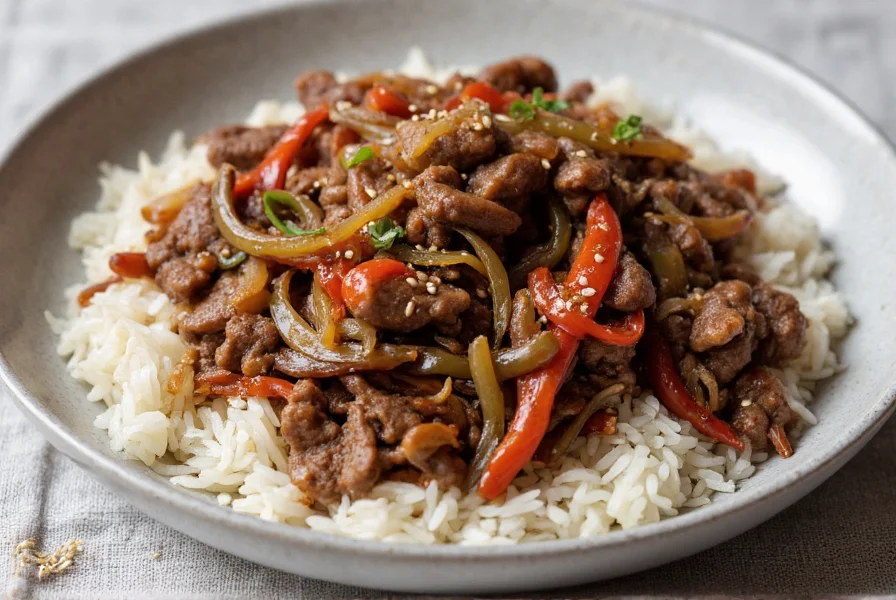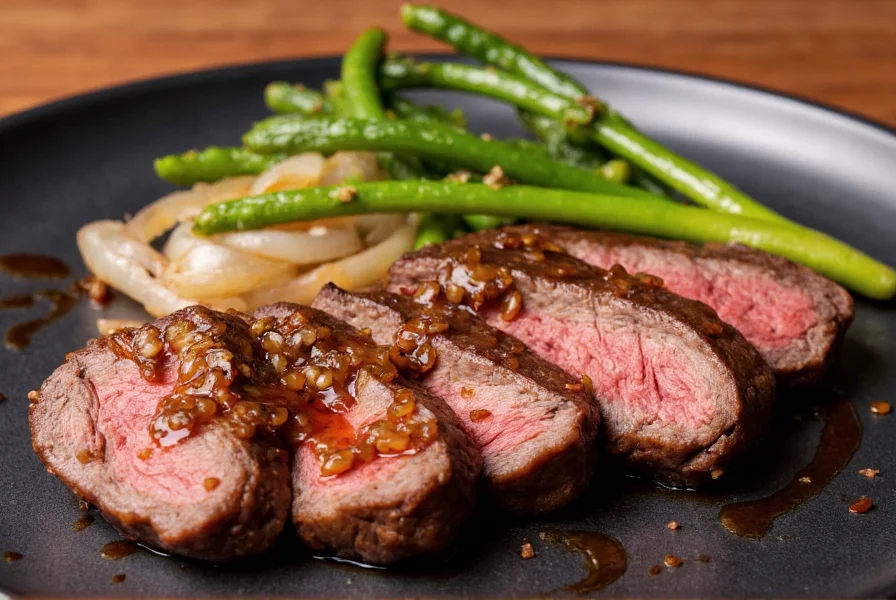While many believe pepper steak with onions is a classic Chinese dish, it actually originated in American-Chinese restaurants during the mid-20th century. This popular menu item represents the creative adaptation of Chinese cooking techniques to Western ingredients and tastes. Understanding its true origins helps home cooks prepare a version that balances authentic stir-fry methods with the familiar flavors Americans love.
The Cultural Journey of Pepper Steak
Traditional Chinese cuisine features numerous beef stir-fry dishes, but none specifically called "pepper steak." The American version emerged when Chinese immigrants adapted their cooking to available ingredients in the United States. Unlike authentic Chinese beef dishes that typically use green peppers (qīng jiāo) or chili peppers, the American version prominently features colorful bell peppers—something rarely used in mainland Chinese cooking.
True Chinese restaurants in China rarely serve this dish, as bell peppers weren't commonly used in traditional recipes. Instead, Chinese cooks would use long green peppers or occasionally Sichuan peppercorns for heat. The American-Chinese version evolved to appeal to Western palates that preferred milder flavors and colorful presentations.
Essential Ingredients for Authentic Preparation
The quality of your pepper steak depends on selecting the right components. While this is an American-Chinese dish, using proper technique creates restaurant-quality results at home.
| Cut of Beef | Texture | Best For Pepper Steak? | Preparation Tip |
|---|---|---|---|
| Flank Steak | Firm with visible grain | ✓ Best choice | Slice thinly against the grain |
| Sirloin | Moderately tender | ✓ Good alternative | Partially freeze before slicing |
| Rump Steak | Firmer texture | △ Acceptable | Marinate longer for tenderness |
| Filet Mignon | Very tender | ✗ Not recommended | Too expensive, overcooks easily |
Meat Selection and Preparation
Flank steak remains the ideal cut for authentic Chinese pepper steak with onions. Its muscle structure responds well to proper slicing technique—always cut across the grain at a 45-degree angle into ¼-inch thick slices. This technique shortens the muscle fibers, creating naturally tender pieces that withstand high-heat cooking.
For optimal results, implement the velveting technique: marinate the sliced beef in 1 tablespoon cornstarch, 1 egg white, and 2 tablespoons rice wine for 20-30 minutes before cooking. This creates a protective coating that locks in moisture during the quick stir-fry process.
Sauce Components
The signature sauce for Chinese pepper steak with onions balances咸 (xián/salty), 甜 (tián/sweet), and 鲜 (xiān/umami) flavors. A traditional American-Chinese version includes:
- 3 tablespoons soy sauce (light for saltiness, dark for color)
- 2 tablespoons oyster sauce (essential for authentic umami)
- 1 tablespoon Shaoxing wine or dry sherry
- 1 tablespoon brown sugar or honey
- 1 teaspoon sesame oil
- 2 tablespoons cornstarch mixed with ¼ cup broth or water
- 1 teaspoon grated ginger
- 2 cloves minced garlic
The cornstarch slurry creates the characteristic glossy finish that clings to the ingredients. For gluten-free versions, substitute tamari for soy sauce and ensure your oyster sauce is GF certified.

Step-by-Step Cooking Method
Mastering Chinese pepper steak with onions requires proper technique more than exotic ingredients. Follow these steps for restaurant-quality results:
Preparation Phase
- Freeze the flank steak for 30-45 minutes to firm it up for easier slicing
- Cut against the grain into ¼-inch thick, 2-inch long strips
- Marinate with cornstarch, egg white, and rice wine for 20-30 minutes
- Prepare all vegetables: slice 1 large onion into wedges, 2 bell peppers into 1-inch strips
- Mix sauce ingredients separately from the cornstarch slurry
Stir-Fry Sequence
- Heat 2 tablespoons oil in a wok or heavy skillet over high heat until smoking
- Quickly stir-fry beef in batches for 1-2 minutes until browned but not fully cooked
- Remove beef and set aside
- Add 1 tablespoon oil, then onions and peppers; stir-fry 2-3 minutes until crisp-tender
- Return beef to wok, pour in sauce mixture (stir cornstarch slurry first)
- Cook 1-2 minutes until sauce thickens and coats ingredients
The entire cooking process should take no more than 10 minutes. Overcooking leads to tough meat and soggy vegetables—both ruin the authentic texture profile.

Common Mistakes to Avoid
Many home cooks struggle with Chinese pepper steak with onions because they make these critical errors:
- Using the wrong cut of meat - Tenderloin or filet mignon overcooks too quickly, while tougher cuts like chuck require different preparation
- Overcrowding the pan - Adding too much meat at once lowers the temperature, causing steaming instead of searing
- Adding cornstarch too early - Creates a pasty texture rather than a glossy sauce
- Cooking vegetables too long - Authentic preparation maintains crisp-tender texture
- Using bell peppers exclusively - Traditional Chinese versions might include long green peppers for authentic flavor
Serving Suggestions and Variations
Serve your Chinese pepper steak with onions immediately while hot. Traditional accompaniments include:
- Steamed jasmine rice (the neutral base lets the stir-fry shine)
- Chinese broccoli or bok choy on the side
- A sprinkle of toasted sesame seeds for texture
- Chili oil or Sichuan peppercorns for those who prefer heat
For dietary adaptations:
- Gluten-free: Use tamari instead of soy sauce and verify oyster sauce is GF
- Lower sodium: Reduce soy sauce by half and add extra rice wine for flavor
- Vegan option: Substitute mushrooms for beef and use vegetarian oyster sauce
- Spicy version: Add 1-2 sliced red chilies with the vegetables
Why This Dish Endures
Despite not being authentically Chinese, pepper steak with onions remains popular because it demonstrates fundamental Chinese cooking principles adapted for Western kitchens. The dish showcases wok hei (the "breath of the wok")—that distinctive smoky flavor achieved through high-heat cooking. When prepared correctly, it delivers the perfect balance of tender protein, crisp vegetables, and glossy sauce that defines quality stir-fry technique.
Understanding its American-Chinese heritage helps cooks appreciate this dish for what it is—a successful culinary adaptation rather than a traditional recipe. By focusing on proper technique and quality ingredients, home cooks can create versions that honor both Chinese cooking methods and the dish's unique place in American-Chinese cuisine.
Frequently Asked Questions
Is pepper steak with onions actually Chinese?
Pepper steak with onions as commonly served in Western restaurants is an American-Chinese creation, not found in traditional Chinese cuisine. Authentic Chinese cooking rarely uses bell peppers in beef dishes, instead favoring long green peppers or chili varieties. The dish evolved in Chinese-American restaurants to appeal to Western tastes using available ingredients.
What's the best cut of beef for Chinese pepper steak?
Flank steak is the ideal cut for Chinese pepper steak with onions. Its muscle structure responds well to proper slicing technique—always cut across the grain at a 45-degree angle into ¼-inch thick slices. For optimal tenderness, use the velveting technique: marinate sliced beef in cornstarch, egg white, and rice wine for 20-30 minutes before cooking.
How do I prevent my pepper steak from becoming tough?
To prevent tough pepper steak: 1) Always slice against the grain, 2) Use the velveting technique with cornstarch and egg white, 3) Cook over high heat for a short time (1-2 minutes), 4) Don't overcrowd the pan when stir-frying, and 5) Remove beef from heat while still slightly underdone as it will continue cooking off-heat. Properly prepared flank steak should be tender with a slight chew, not stringy or tough.
What gives Chinese pepper steak its glossy sauce?
The glossy sauce characteristic of Chinese pepper steak comes from a cornstarch slurry (cornstarch mixed with cold liquid) added at the end of cooking. When heated, the cornstarch thickens the sauce, creating a shiny coating that clings to the ingredients. For best results, mix 2 tablespoons cornstarch with ¼ cup broth or water, then stir into the hot sauce just before finishing. The sauce should coat the back of a spoon but still flow smoothly.
Can I make Chinese pepper steak with onions ahead of time?
While Chinese pepper steak is best served immediately, you can prepare components ahead. Slice and marinate the beef up to 24 hours in advance. Cut vegetables and prepare sauce up to 2 days ahead, storing separately. However, complete stir-frying must be done just before serving to maintain proper texture—meat becomes tough and vegetables lose crispness when reheated. For meal prep, cook components separately and combine only when ready to eat.











 浙公网安备
33010002000092号
浙公网安备
33010002000092号 浙B2-20120091-4
浙B2-20120091-4